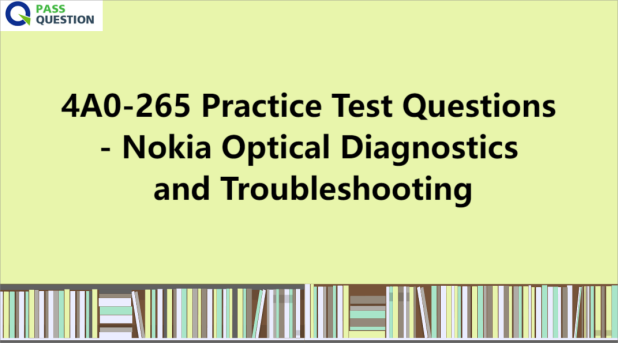4A0-265 Practice Test Questions - Nokia Optical Diagnostics and Troubleshooting
To ensure your success in the 4A0-265 Nokia Optical Diagnostics and Troubleshooting exam, we highly recommend utilizing the comprehensive resources provided by PassQuestion. By choosing the latest 4A0-265 Practice Test Questions from PassQuestion, you will have access to a wide range of preparatory materials that will assist you in thoroughly preparing for your exam. These 4A0-265 practice test questions have been designed specifically to align with the exam objectives, allowing you to familiarize yourself with the content and format of the actual exam. By investing time and effort in studying these 4A0-265 practice test questions, you will significantly enhance your chances of passing the exam with flying colors. Don't miss out on this valuable opportunity to boost your exam performance and achieve success in your 4A0-265 Nokia Optical Diagnostics and Troubleshooting certification journey.

Nokia Optical Diagnostics and Troubleshooting
Candidates who pass the 4A0-265 can explain 1830 PSS node optical signal flow, EDFA Raman amplification, and active alarm/PM retrieval. They can locate EPT commissioning data, WT detection points, wave key sources, fiber cuts. They configure fault isolation and power management settings and troubleshoot alarms/power adjustment failures/OSC issues. Adjust channel power and calculate span loss, and can resolve FEC configuration, payload type/encapsulation mode, and fiber connection issues.
Passing Nokia Optical Diagnostics and Troubleshooting exam will help you earn the knowledge and hands-on skills required to troubleshoot and resolve Nokia photonic nodes' issues using direct web and command line interfaces. Participants will learn optical signal flow through a node using the Nokia 1830 Engineering and Planning Tool (EPT) reports for consistency analysis, retrieving optical power data and current alarms/conditions, troubleshooting and repairing a transmission, and system/optical transponder faults.
Exam Information
Exam name: Nokia Optical Diagnostics and Troubleshooting
Exam number: 4A0-265
Mandatory prerequisites: none
Exam duration: 90 Minutes
Exam appointment duration: 110 minutes. This is the exam duration plus a 20-minute introductory survey.
Number of questions: 40
Language: English
Price: $125 US
Exam Modules
Module 1 – Documentation and Support Information
Module 2 – Optical Signal Flow
Module 3 – EPT report parameters
Module 4 – Alarms, conditions and logs
Module 5 – Performance monitoring and loopbacks for troubleshooting
Module 6 – Transmission and power adjustment troubleshooting techniques
Module 7 – Wavelength Tracker
Module 8 – Line issues troubleshooting and alarm correlation
Module 9 – Optical Transponder configuration troubleshooting
View Online Nokia Optical Diagnostics and Troubleshooting 4A0-265 Free Questions
1. Which of the following statements about optical power vs amplification stages is TRUE?
A.Ingress amplifiers are always more powerful [than egress amplifiers, to reduce the impact of non-linear effects.
B.When channels pass through amplifiers, all of them always experience a similar amplification.
C.When multiple channels pass through a shared port (for example, an amplifier line interface), the total aggregated power reflects the number of channels currently present.
D.The Optical Supervisory Channel (OSC) is amplified when passing through all amplifier types, except for Raman which is not based on EDFA.
Answer: C
2. Which of the following statements about the alarm masking mechanism is TRUE?
A.The alarm masking mechanism makes sure that alarms are always present on the downstream interfaces to facilitate the troubleshooting process.
B.The alarm masking mechanism updates the events' original time stamps when it masks/shows alarms, so that when an alarm is not masked anymore, the user can see the updated date and time associated with the original issue.
C.The alarm masking mechanism always forwards masked alarms to an external Network Management System (NMS) for alarm correlation.
D.The alarm masking mechanism preserves the events' original time stamps, when related alarms gets hidden and then eventually displayed because of the mechanism itself, so that the user can still know the date and time of the original issue.
Answer: D
3. Which of the following is NOT a characteristic of an Optical Supervisory Channel Loss of Signal (OSC LOS) issue, in case that no "LD Input LOS" alarms are raised against the involved amplifiers?
A.An "Incoming SUPVY LOS" alarm is raised on the local node.
B.A "Data Link Down" alarm is raised on the adjacent node.
C.A "Power Adjustment Required" alarm is eventually raised on the local node.
D.Traffic does not pass between the local and adjacent nodes.
Answer: A
4. Which of the following is a passive component in a CDC-F network configuration?
A.130SCX10 Optical Transponder
B.MSH4-FSB Fiber Shuffle Module
C.WR20-TFM Wavelength Router
D.IRDM20 Integrated ROADM
Answer: B
5. Which of the following statements about the "config powermgmt egress 1/2 adjust status command" is TRUE?
A.The command displays the status of power adjustment on the specified egress amplifier.
B.The command enables power adjustment feature on the specified egress amplifier, as this feature Is always and only available at the egress amplification stage.
C.The command enables power adjustment feature on the specified egress amplifier.
D.The command displays commissioning status and WT decoder usage for the specified egress amplifiers only, as this feature is always and only done in the egress direction.
Answer: C
6. Which of the following statements about using Nokia product documentation in the troubleshooting process is TRUE?
A.Before investigating a problem it is important to check the Engineering and Planning Tool User Guide (EPTUG) if a possible issue has already been acknowledged by the Product Unit (PU).
B.The Customer Release Notes (CRNs) provides instructions to perform the automated provisioning, commissioning, and power balancing functions in a customer network based on the Nokia 1830 PS5 platform.
C.Before investigating a problem it is important to check the User Provisioning Guide (UPG) if a possible issue has already been acknowledged by the Product Unit (PU).
D.The Customer Release Notes (CRNs) document collects documented solved known issues, new issues discovered after the product software has been released.as well as software upgrade procedures and firmware details.
Answer: D
- TOP 50 Exam Questions
-
Exam
All copyrights reserved 2025 PassQuestion NETWORK CO.,LIMITED. All Rights Reserved.

